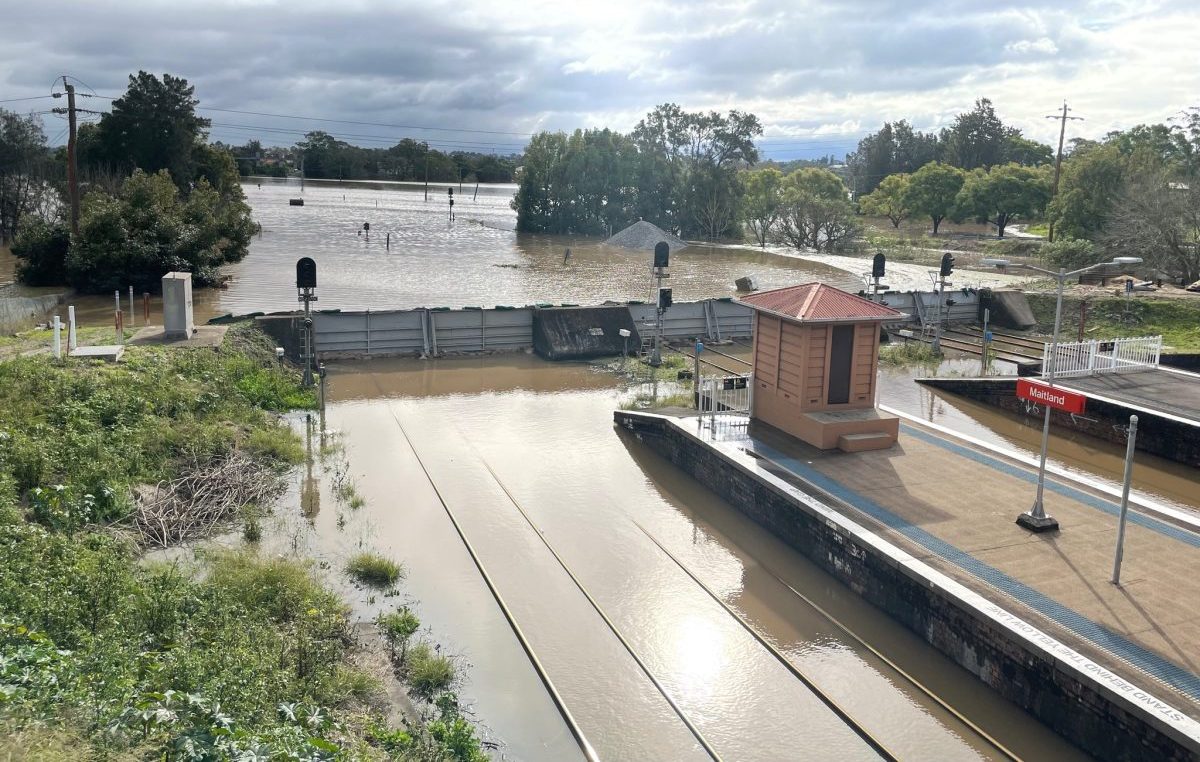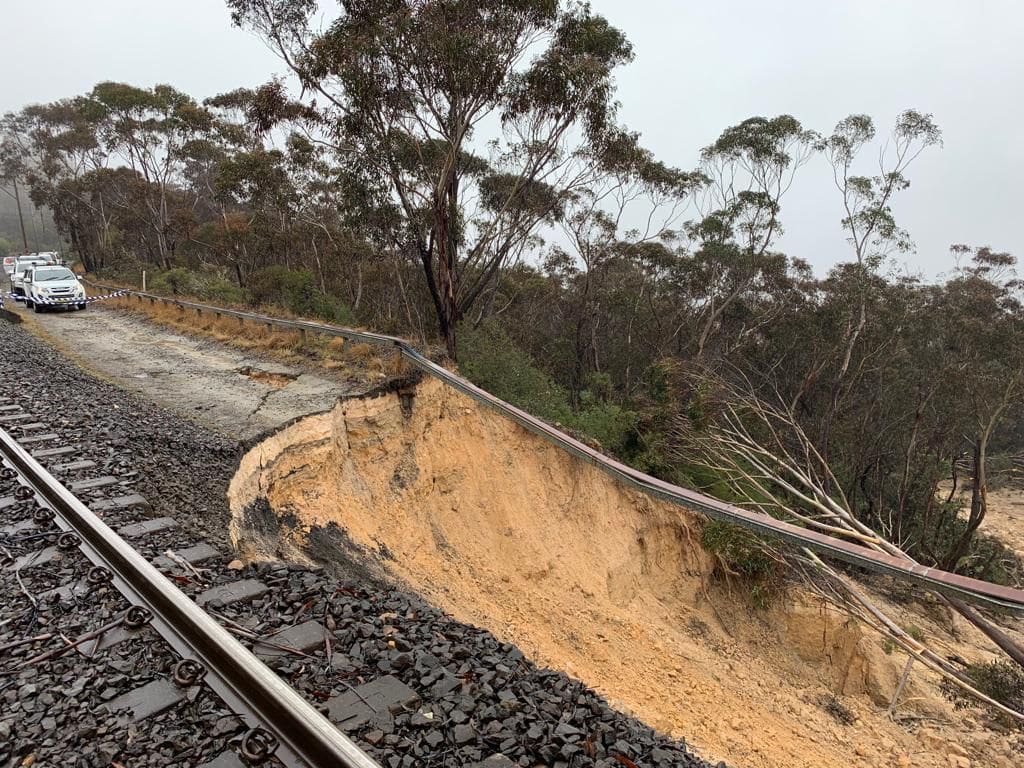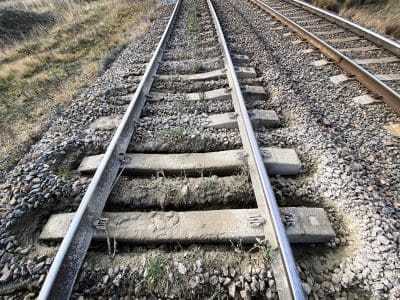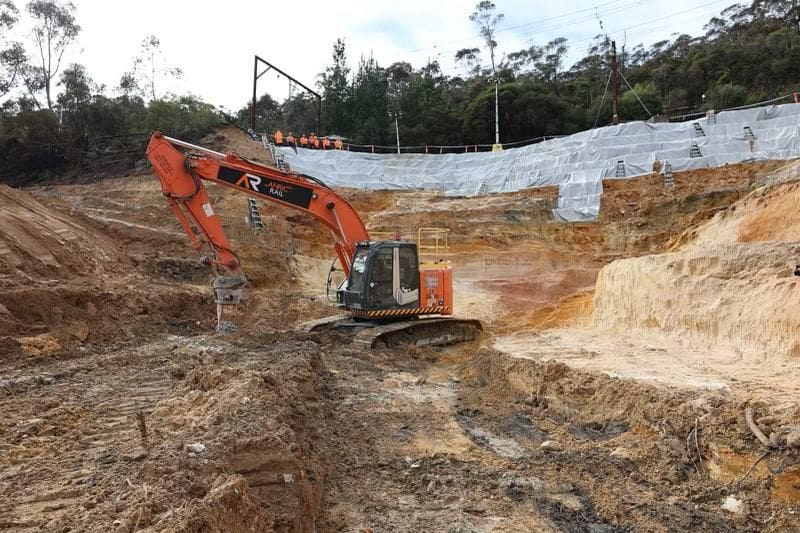
The Hunter Valley rail line is impassable at Maitland, where floodgates were closed July 6 to protect the city. Photo: Transport for NSW
DAMAGE to a section of rail line at Gunning on the Southern Tablelands of New South Wales has further throttled the supply chain for grain, meat and cotton bound for domestic and export customers.
The Gunning incident occurred on Sunday when a locomotive hauling wheat to a flour mill near Sydney lost traction on one rail of the dual track operated by lessee Australian Rail Track Corporation (ARTC).
It is the latest in a string of rain-related incidents that has shown up the fragility of the NSW rail-freight network, and has left some domestic consumers and most exporters with critically low stock levels.
Floods keep coming
Pacific National (PN) is the major hauler of grain in NSW, and a company spokesperson today said that since July 4, around 43 per cent of planned grain services across NSW have been cancelled due to disruptions caused by heavy rain and associated flooding.
“Approximately 82,000 tonnes of grain – both domestic and export – has been unable to be delivered to the production plants and ports, resulting in ongoing disruption and delays to our customers and the export supply chain,” the PN spokesperson said.
The Gunning derailment means only one line on all three freight routes into Sydney is operating to carry bulk grain and containerised grain, cotton and meat to NSW’s coastal destinations.
Flooding earlier this month closed the Hunter Valley Rail line, which stopped the passage of grain trains to Newcastle’s two bulk grain terminals, GrainCorp’s Carrington facility and Qube’s Newcastle Agri Terminal.
The Hunter line also carries containerised grain and cotton from northern NSW to Sydney’s Port Botany.
Industry sources said they had initially hoped the Hunter line might reopen on Monday, but ongoing flooding and the need to ensure the network can be operated safely mean ARTC is not yet in a position to speculate on a date for the line’s reopening.
The same rain event also closed the dual line from central NSW to Sydney over the Blue Mountains.
This line carries bulk grain and containerised commodities from sites including Bathurst, Dubbo, Parkes, Trangie and Warren.

The rail line at Blackheath in the Blue Mountains is closed to allow remediation work following the landslip caused by torrential rain earlier this month. Photo: Transport for NSW
The Moss Vale-Unanderra line carries grain to Port Kembla’s two export terminals, the GrainCorp facility and Qube’s Quattro, and Manildra’s Shoalhaven Starches plant.
It has been closed since March, when torrential rain destabilised embankments, and ARTC has advised this line is expected to reopen in September.
Limited paths
Sources say agricultural freight is now competing for rail paths through the network used by Sydney passenger trains, and some operators are able to run only one in three trains.
“Sydney is almost isolated,” one source said.
“It’s affecting grain, cotton, and regional freight.”
“I don’t remember a point where you’ve had all three lines reduced.
“These are major lines and they should be all-weather.”
Road transport is having to fill the breach left by limited rail deliveries at domestic mills and export terminals.
“The transport of grain bound for export from GrainCorp’s Carrington port has been impacted by severe weather events that resulted in the closure of the Hunter line at Sandgate and Maitland,” a GrainCorp spokesperson said in a statement.
“At this stage, the impact on the industry is expected to continue until the floodwaters recede and the track is recertified as fit for use.
“We continue to accumulate grain for road transport to port and we’re working with the ARTC and our rail partners to get the line up to capacity as quickly as possible.”
An ARTC spokesperson said flooding caused closures to the Hunter line from July 5 at locations including Maitland, Sandgate and Singleton, and while some services are operating east and west of Maitland, the through line remains closed.
“Although water levels have receded marginally, they are still far too high to consider a return to normal service.”
ARTC said “major restoration works” were already under way on the damaged track near Gunning following Sunday’s derailment.

Heavy and successive rain events in regions surrounding Sydney have destabilised sections of track including this one at Gunning, where Sunday’s derailment occurred.
“Our contractor crews began work on site on Tuesday morning and started work at the southern end of the work site; additional contractors began work on site on Wednesday.
“Their work will include the replacement of more than 3000 concrete sleepers as well as replacing and repairing a significant amount of rail.
“ARTC has been able to operate a restricted service on the down main but services will continue to be delayed in both directions until the restoration work can be completed.”
“A period of no-train services is in place between 7am and 7pm as of today, and will be in place until restoration works are completed.”
Work under way near Blackheath
In a media release issued today, Transport for NSW said crews were already working to rectify the Main Western line between Blackheath and Mt Victoria following last week’s rain-related landslip.
Minister for Regional Transport and Roads Sam Farraway said it will take six weeks to fully restore the major rail-freight corridor, and freight services will be prioritised over passenger ones.
Mr Farraway said 40,000t of gabion rock will need to be imported to build up the embankment and slip.
“My number-one priority is to get the Main Western line opened as soon as it’s safe so that freight operations can commence, followed by passenger services.”

Crews are working to rectify the rail line near Blackheath, and limited freight services could be running by the end of this month. Photo: Transport for NSW
Mr Farraway said Transport for NSW was working closely with the freight industry and rail operators with a goal of resuming some freight services in two weeks by opening the track some distance from the landslip.
“This option strikes the best compromise between keeping freight moving through that section of the track and restoring the line as soon as possible,” Mr Farraway said.
“We have crews working day and night to repair the damage with teams of about 70 a shift and these numbers are set to surge to over 100 people at the height of work.”
In a statement provided to Grain Central, a spokesperson for Transport for NSW said in the aftermath of the most recent extreme rain fall, Sydney Trains was prioritising responding to and repairing damage to the parts of the NSW rail network it manages.
“Measures to improve the long-term resilience of these rail lines can be addressed once these repairs are completed,” the spokesperson said.
The Blue Mountains line is part of the Sydney Trains network.
Grain Central: Get our free news straight to your inbox – Click here

HAVE YOUR SAY